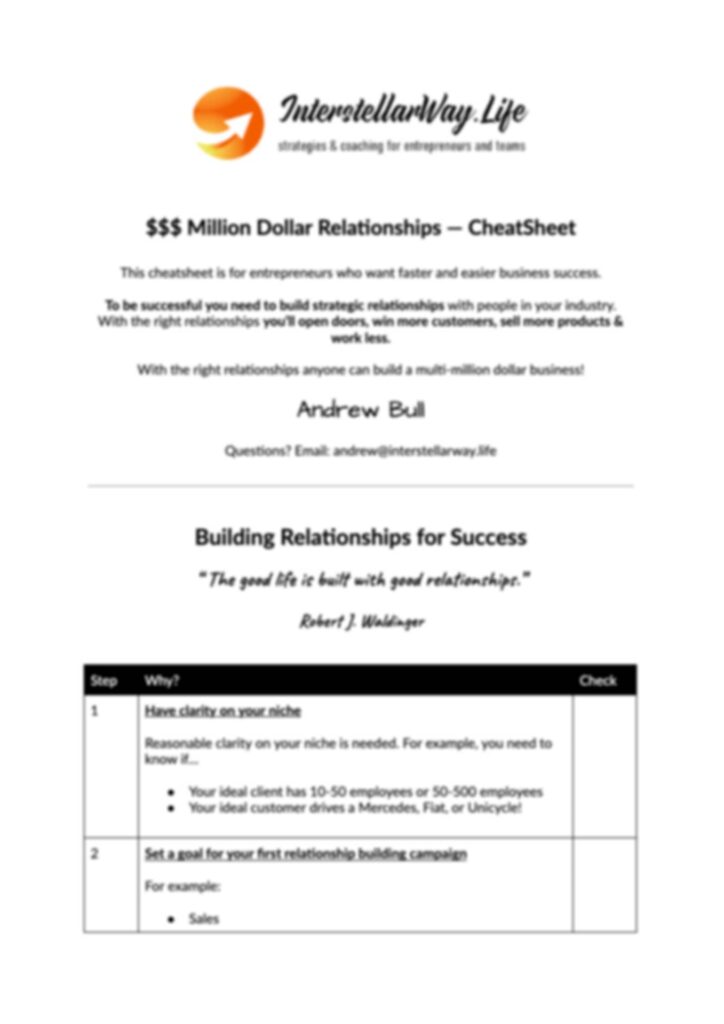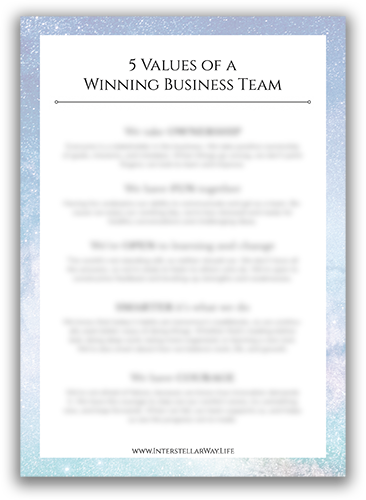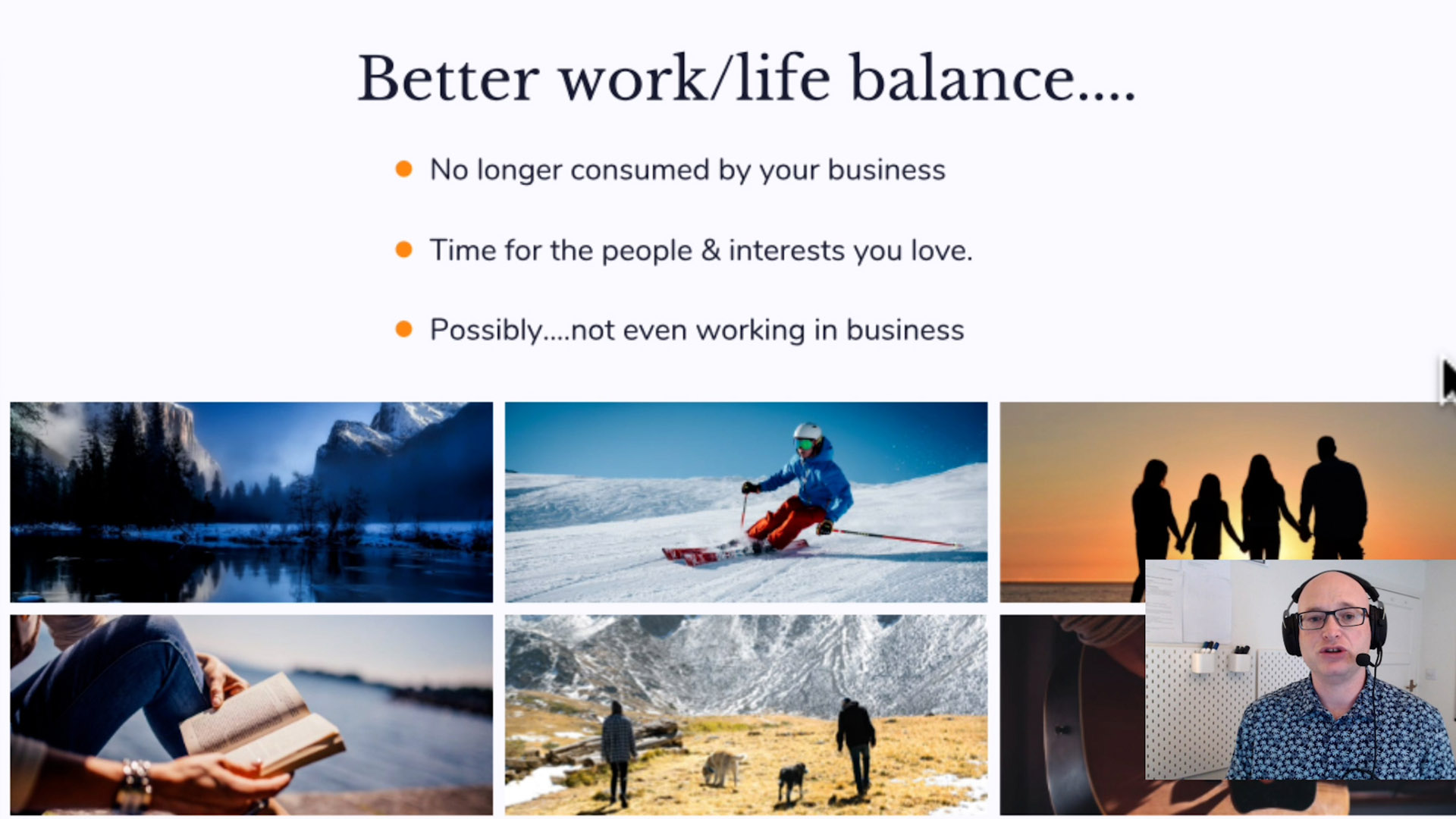Interstellar Business Show
Podcast for Technology CEOs and their teams.
It's time to grow your mind, elevate performance, and own your future 🚀

Interstellar Business Show
Episode: 0001
Pricing for leaders: Mark Peacock on pricing tech services the right way
Featuring....

Episode Introduction
On this show, Andrew discusses pricing strategies with Mark Peacock, The Pricing Coach. If you run a technology business, and you’re not sure if you have the right pricing in place, you need to listen to this week’s episode and get the benefit of Mark’s insights and advice. Plus, Andrew explains why the podcast is called the Interstellar Business Show, and what you can expect from future episodes.
Episode notes & resources
Want to connect with Mark Peacock or ask him a question?
You’ll find Mark here:
Website: https://www.markpeacock.co.uk/
Twitter: @ThePricingCoach
LinkedIn: www.linkedin.com/in/mark-peacock-the-pricing-coach/
Facebook: https://www.facebook.com/mark.peacock.39750
Transcript
Please note, this transcription is autogenerated, so there may be errors.
Andrew Bull 0:15
Hello, and welcome to the very first episode of the interstellar business show, hosted by Andrew bull of bright arts agency. This is the podcast for technology companies and business owners who want to smarten up their act. Stay tuned for ideas and advice that will help you grow more, work less and enjoy life. Coming up on today’s show, I’ll be talking with Mark peacock the pricing coach. Have you ever wondered if you’re using the right pricing strategy? Or whether your services are priced too high or too low? We’ll worry not Mark Scott the answers for you. Yes, in today’s episode, we are going deep on pricing. And by the end of the podcast, you’ll finally understand why and how your business should be improving its pricing. Coming up on today show I’ll be talking with Mark peacock the pricing coach. But first, as this is the very first episode, I wanted to share with you my inspiration and ideas for this show. And I think a good place to start is with the name, the interstellar business show. Why Interstellar? Well, it’s inspired by Christopher Nolan’s film off that name, the movie Interstellar brilliantly touches on the preciousness of time, especially the fleeting time we share with loved ones. Now, spoiler alert coming up, if you haven’t seen Interstellar, you should go away and watch it now. It’s a brilliant film. Okay, but I’m going to be talking about it now. So yeah, I’ve was skip ahead of you must. So carrying on with my explanation. At the end of the film, Matthew McConaughey, his character is finally reunited with his daughter after being away in space. But here’s the catch. Time for him has moved at a different pace. So when they’re finally reunited, his daughter is now an old lady. Well, he’s only aged a few days, he may have completed his mission, but he’s done. So the cost of missing out on his daughter growing up. And I think this is the risk that many business people face, that we’re so wrapped up in our business mission that we miss out on life. We miss out on the things, friends and people that we love. Let me ask you, do you ever feel like Matthew McConaughey his character strapped to your rocket your business with life rushing by? I know I do. And I think the challenge for today’s business people is finding a way to balance business growth, work experience and quality of life. So this show is not only about how you can grow your business the smart way. It’s also about how you can work and live smarter. I hope to bring you insights and interviews that will make a tangible impact on these three areas of your life. Of course, we’ll be talking about today technology and business strategy, but will always do it with an eye on the triple bottom. Your business growth, work experience and quality of life. Now I can read your mind. You’re wondering, What does Andrew mean by work experience. I mean, we’ll be talking about the work you do during the day. We spend a long time at work. I think it’s important you spend time doing work that you love, or work that moves the business needle. And I certainly don’t think you should be doing boring, repetitive, or frankly, sometimes pointless work. So I’ll be doing my best to share ideas that will help you and your team have a better working day. So you can grow work and live smarter. Okay, that wraps up my explanation for the show. Right. Let’s move on to this week’s guest. So I’m pleased to welcome to the show today Mark peacock the pricing coach. Welcome mark, he tell us a little bit about what you do.
Mark Peacock 3:57
Morning, Andrew. Yes. So as the name implies, I’m a pricing coach, I help businesses improve their pricing. Pricing is what I think is the most important part of your business. Yet also often, it’s the one aspect that most business owners leave to last to think about how they can improve it. But actually, there’s loads of simple things that any business can do to improve its pricing. So that’s what I do I help businesses get to a better place where their pricing strategy,
Andrew Bull 4:24
And why do most business owners fail to get started with their pricing and fail to improve it?
Mark Peacock 4:28
I think there’s a number of reasons I think fear plays a big part in that. So we’re afraid to put up our prices because, you know, we think will lose customers or think will lose sales volume. And also we don’t know how our competitors react. So it’s the fear of the unknown. Also, there’s a lack of awareness of what other pricing strategies that businesses could use. I show people that there are loads of different ways to think about pricing, none of them are difficult in terms of what I teach. And they can all make a significant difference. But there’s a lack of awareness as to what you can do with your pricing. So your fear, lack of awareness and also a degree of inertia. I think, you know, businesses, once they’re up and running, they just get stuck with their pricing method. You know, they can’t they find something that works, okay. And they just stick with it. And then they failed to renew or update their pricing strategy as the business starts to grow. So I think those are the main reasons why why people don’t don’t look at their pricing more often.
Andrew Bull 5:30
What do you think most people are actually getting wrong with their pricing right now?
Mark Peacock 5:34
I think the main thing is most businesses are underpricing and undervaluing what they do. And that’s driven by competitive forces in your market your industry. You think that if other people are undercutting you, you need to do the same just to keep up as it were. And also, we tend to remember the last difficult conversation that we had with a prospect where price was the most facts, and they were trying to batter you down. We remember that more than the situations where we have one business with customers who are willing to pay more. So that influences our thinking. And we decide that price is the most important factor. Whereas in fact, it’s just one of many reasons why why people buy from you. So, underpricing what we do undervaluing not charging correctly, all the consequences of not looking at our pricing more carefully, I would say.
Andrew Bull 6:26
And I would say people worry that their prices are too high, and therefore not wanting to do it. And you know, they get it wrong, because that is sometimes because they’re not doing a good enough job of explaining what they do to people. So actually, I took if they did a bit a better job of explaining the value they deliver, then actually, they probably find it easier to justify the pricing to themselves and their clients.
Mark Peacock 6:49
Absolutely. Right. So if you know, if you have got a slightly more of a premium price position is really important to work out, you know, your sales story to support that, you know, I say price as both an art and a science, the sciences? What’s the number, the art is? How do you communicate that number. And being clear on your reasons for how you communicate that price and justify are just as important as working at the number itself. So completely agree.
Andrew Bull 7:16
And in terms of a priority. So we’ve got the three areas of our business that we could work on cutting costs, increasing volume, getting more clients, and then and then pricing Pantheon should pricing be to our businesses?
Mark Peacock 7:29
Yeah. So I think you know, the three things you talked about, they’re all key drivers. So if your profit, so price times volume minus your costs equals your profit. But generally, I think most business owners spend most of their time focusing on revenue or volume growth and or cutting costs. Whereas for me, price is the one we spend the least amount of time thinking on. But actually, if we spent more time thinking on it, it would deliver a significantly more value. There’s loads of studies that show, for example, McKinsey quotes, a 1% improvement in price can lead to a 10% improvement in profits, I have other studies that show a 5% improvement in price can lead to a 20 or 30%. improvement in net profit. So a small, small improvement your price can make a big difference the bottom line, but obviously you’ve got to do it in a way that your customers are going to value and still going to want to buy. And and that is perfectly possible. And that’s that’s what I’m that’s what I’m about helping people achieve.
Andrew Bull 8:33
I’m a big fan of pricing the right way, as well. And yeah, I really loved your talk. And I just think is so important for businesses that we do need to look at it and not only looking at once, how we need to work on on a long term basis, right?
Mark Peacock 8:46
Absolutely. Pricing is not just something you do once a year when you set your budget, it’s something you need to be constantly reviewing. Because ultimately, it’s about your value proposition, you know, what do you do adds value to your customers? And how can you improve it so you should never stop, you know, worrying and thinking about that. So I always encourage people to, you know, have at least quarterly pricing reviews, not necessarily to make a change, but to make sure it’s still working. And then also think about in your three year business plan. If you have one, setting your target prices for the after three years and working out a plan for how you want to get there, rather than pricing just being a number, an input or a calculation. That’s done once you’ve worked out your costs and your volume. So yeah, I think it’s really important. And I would encourage everybody to spend a lot more time on it, because it has a massive impact. And actually, it doesn’t have to be scary or difficult. There’s lots of ways to cope with it and talking about impact.
Andrew Bull 9:51
I personally believe that pricing not only impacts your profit, but is also branding and positioning issue as well. Would you agree with that mark?
Mark Peacock 10:01
Completely, I’m sure you know Seth Godin, the famous marketing thinker. So he he quotes that pricing affects your marketing, marketing affects your pricing. And what he means by that is that the two have to be in sync, your branding, your marketing, your pricing, all have to work together. You wouldn’t catch Apple with premium products at premium prices and poor marketing, would you so it’s absolutely fine. So if you’re trying to present a high quality service, and you’ve got cheap prices, there’s a disconnect between the two. And people will see that and they’ll see through price, there’s a massive influence on our on your customers perception of quality. And if it’s not correctly aligned, people will see through it and they won’t value they won’t trust what you’re offering, as much as if you have correctly aligned your pricing with your product and your marketing and your brand. So absolutely. they’ve they’ve all got to work together.
Andrew Bull 11:01
Do you think that remains true whether you’re selling Ferrari’s or whether you’re selling technical services to people,
Mark Peacock 11:08
Definitely, it applies to any product or service b2b to say so the Ferraris of the world they, they tend to get this, right. So you know, high value cars with high prices. But, you know, there’s lots of reasons why people want to buy Ferrari has nothing to do with need, nobody needs a Ferrari, but everyone wants one, right. So it’s about selling the emotional package as much as the rational package, which is the car itself and all the features, or whether you’re selling technical services, or marketing services, or whatever it is that you do, setting your pricing strategy correctly in line with your you know, what you want for your business where you want to get to what your customers value is really important, and actually can unlock quite a few problems if you approach it correctly.
Andrew Bull 12:00
And going back to the Ferrari, luxury cars arereally interesting to me, because I think about the price of the parts that go into that car, compared to the price that you know, a Ford Fiesta at 20,000 pounds and a Ferrari a half a million up. But there’s not the cost of parts. The Ferrari hasn’t got you know, 20 times the amount of parts in cost. Part of the price is justified fruit fruit, the ticket price, you know, exactly, because it’s exclusive, that helps to keep the price up and the value up as well.
Mark Peacock 12:30
Yeah, absolutely. So any product, you know, that has what I call prestige pricing, so luxury cars, luxury watches, luxury fashion items, the custom manufacture, the product itself will have no bearing on the price. And the price is determined by things like the brands and what it represents the emotional appeal of the products, and possibly, you know, the level of r&d that’s gone into creating that product creating the brand in the first place. And this is one of the most important lessons that we need to understand is the pricing is not linked to cost. Pricing has everything to do with what customers perceive as value. And it has nothing to do with your internal costs to deliver or produce that product or service. We so often we get stuck on this issue of well, I need to know my costs. So I can add a margin on and calculate the price. That’s what every everybody does, initially. And it’s a way of doing your pricing. But it’s also one of the least effective ways I would suggest. So yeah, we can learn a lot from the prestige guys. But also things like coffee, right? You know, what’s the marginal cost to buy a latte in your favorite High Street brand, it’s minimal, but you’re happy to pay 234 pounds for that coffee, even though it’s unit cost is probably less than 50 paid. So you’re buying into, you know, the brands, the experience, the quality of the products that you’re expecting, and all sorts of things. And that’s what and the price is set at a level to reflect and capture that value. So yeah, thinking about value pricing is, is really interesting. And it’s we can we can learn lessons from lots of other brands and manufacturers as well.
Andrew Bull 14:21
And so moving back towards maybe service and technical service businesses, I’m just thinking about how we can create that extra premium value, do you think like having accreditation, or let’s say someone like SAP, for example, a huge software company, I suppose having them on your website, gives you a bit of value?
Mark Peacock 14:43
Yeah, definitely so or anything that you can do to add to your credentials, to your you know, your overall brand, what it represents your expertise, these are all good things to have, you know, there’s nothing I would say that wouldn’t encourage that approach. So having critical skills, you know, I was ISO 9001, or whatever it is that these are all good things because they all add to the value of the brand. And that’s what people are buying into. You’ve got to sell the overall proposition, create the overall value proposition and then put, you know, a price in line with that. So, yeah, that those are all important that I would say prerequisites for good pricing. But you’ve also got to have you know, great service, great products and great see, you know, offer great value. All of those things need to come together. And then you can put a good price on what you do.
Andrew Bull 15:36
Yeah, you can’t just go and stick a high price on something. Yeah. So moving on to some more practical tips and ideas for our listeners. Yeah. How would they know if they’re charging little too little? Or too much? Is there an easy way of knowing that?
Mark Peacock 15:51
Yes, really good question. I think the answer is it will come from your customers or your prospects reactions to your your prices and your proposals. So for example, if if you know what your sales conversion rate is, for example, so from every proposal that you send out, so the sales that you actually get, if your sales conversion rate is significantly higher than, you know, 60 70%, then you might be too cheap, because you’re converting too many too easily. Equally, if your if your conversion rate is very low, less than 10%, the maybe you’re too expensive. So that’s one thing you could look at. The other is just listening to the feedback from your your customers and your prospects. So you know, there’s, there’s a simple process you can do called win loss analysis. So just look at, you know, the last 20 clients that you’ve won, and write down the reasons why you think you won that business and the last 20 prospects that you didn’t win and write down Why you didn’t think you won that business. And it won’t always be about price. There’ll be lots of reasons. So you need to work through that and try and glean what what’s important to those prospects that you lost, why you didn’t win the business. And actually, I just like to say, I’ve actually got a blog post on the bright arts website, which actually takes you through that process of educating yourself about what happens when you lose the sound how you should learn from that. exactly that. So yeah, really good, really good process. And then the final one is just, you know, a little bit of gut instinct, I think, you know, if you’re talking about your prices, and you’re not getting much pushback, or you know, you’re renewing annual contracts, and that you know that it’s all a bit easy, then that that would be a signal to me that you could think about improving your pricing without much impact.
Andrew Bull 17:43
So I guess it’s almost a matter of friction that we’re talking about, if you have no friction at all, maybe your prices are too low. And if you have too much friction, then your prices are probably too high. Would that be a simple way of putting it?
Mark Peacock 17:56
I think that’s a good, that’s a good analogy, or I think, yes, you know, that’s a good phrase, the level of friction you’re experiencing, your sales and marketing activity will indicate to you the degree to which you got your pricing, right or wrong.
Andrew Bull 18:13
What I would say is, though, when you are putting your proposals together for people don’t when people say something is expensive, or the price is high, don’t immediately think that they don’t want to buy it, and that they won’t buy it at that price. Because people always going to complain that some of the expensive, it’s a natural, it’s a natural way of doing if you’re going to go buy a new house, it’s still going to be more expensive than your last one or your next car is going to be expensive. So I think you need to you need to be prepared for that as well.
Mark Peacock 18:40
Yeah. To two suggestions on that point. If somebody says that then one answer. If somebody says it’s too expensive, then one one response could be compared to what? So what are they comparing it back? You know, that that statement, you know, what are they judging the value of what you’re doing against the something else? And the second question make there is that there will always be somebody who’s cheaper than it. Always, always, always, anybody can sell cheap as your job, how to work out how to add more value. So don’t get caught up in that price battle, work out how to add more value and charge a fee. that’s appropriate.
Andrew Bull 19:15
Okay, so moving on how easily can you change your pricing, can I just wake up tomorrow morning and put my prices up? Or does it need a more considered approach?
Mark Peacock 19:25
Well, you could, of course, but I would always endorse having a well thought through plan of attack before you just put your prices up. So one answer to that is, it’s very easy to put your prices, of course it is you just changed the numbers on your website or on your price list or whatever. But you know, behind that you do need a well for through plan and well thought out strategy. So that’s what I help people do. But the point I would try and make here is it This doesn’t need to be overly difficult or overly complicated. So pricing for me is about thinking about what your customers value, what your product or service offers, in terms of value, what your competition are doing. And you know, what you want as a business, thinking about all of that through the lens of price through the perspective of price. And actually, once you’ve done that, having a well thought through plan, which only needs to be couple of pages, it doesn’t need to be a huge, great documents, that gives you huge confidence, once you’ve worked it out properly, that gives you a huge confidence then to go out to the market and say, Well, this is what we do. This is the value that we offer. And these are the prices that we charge. And this is why once you’ve worked out all of those reasons, it makes it a lot easier for you to be clear about who you want to target, the price you want to sell out. And also, you know billing be willing to walk away, when some you know, you do get that person who wants the cheapest price. And it’s not something that you want to, you know, engage with. So being willing to walk away, is also one of the most powerful pricing strategies that you can have, because you’ve worked out exactly who you want to target, what you think the value is that you’re going to offer them. And the price for that level of service.
Andrew Bull 21:14
I think it’s affected by maturity of your business, or your current product or service that you’re trying to get more sales for. In the I suppose if you’re a mature business, and you’ve got good case studies that show that you work for a certain type of person, you deliver a certain type of result, and this is how much your investment is to get that result, then I think you’re coming from a very strong position and why should you compromise?
Mark Peacock 21:41
Exactly, exactly right. So I think that definitely helps. So having a good track record, you know, evidence, case studies, that’s all going to add to your credibility, and you should use that then so you know, bolster and justify your price positioning. Whereas if you’re just starting out, that’s always a lot harder. But I would say to anybody who’s just starting out terms of their price positioning, don’t start cheap, because you knew, try and aim at the top of the market in terms of price and work out how you can add more value than your competitors. And do it the other way around. You know, I was speaking to a business not not so long ago. And they had like, a 25 years of project management experience in the corporate world. And they were setting up a project management consultancy. And they’d only been going a couple of months and felt they couldn’t charge high prices, because they were new, as a you know, as a new business. But I said Hang on, you’ve got 25 plus years of corporate experience, that’s what people are buying into. So you should price that in price that experienced it and position yourself at the top end of the market. So yeah, so thinking about, you know, business maturity, whether your startup or an existing business is an important point.
Andrew Bull 22:55
Yeah. And also actually, there’s an argument for of course, if you’re a young in the business, then maybe you’ve got there’s a value to that as well that you’re doing new things that other more established businesses might be that might not be doing.
Mark Peacock 23:09
Yeah, yeah, definitely. So if you’re, if you’re adding something new, something innovative, innovative is different. Definitely think about how you can price that to your advantage, rather than just following the herd and just copying. Yeah, definitely.
Andrew Bull 23:24
So one of the one of the going back to one of the reasons people don’t start changing their prices to stay, you know, start improving their pricing is to deal with the fear, and especially fear of going back and talk to their long term clients, and moving them on to different pricing packages or higher pricing packages. How what’s the best approach with that? What should we be doing? Yeah, so I think,
Mark Peacock 23:47
Yeah, I think, you know, let’s see being, you know, fairly well established business, and you’ve got, you know, good set of clients, that you’re just scared to have that price conversation with them. I mean, before we have that conversation, we need to work out the plan, right, we need to work out our strategy, which could be as simple as well, we think we, we need to put our prices up by, you know, three to 5%, or whatever the number is, because we haven’t put our prices up for a number of years. And you know, our costs are rising, just like everybody else’s. So we need we need to implement an inflationary price increase. So if that’s the least that anybody is going to do, I would encourage that because nobody is immune to inflation. The trick then is to work out your your sales script for that conversation or for that, you know, that letter that you gotta send. So you explain what you’re doing on why very clearly, we’re putting up our prices by three to 5%. And the main reason for that is because our costs have increase, but then you have to have to go back to selling hard what you do. So the rest of the conversation or the communication is about explaining why you still represent great value for money, you’re committed to providing the best possible levels of service to your customers, so on and so on. So you have to work out that sales scripts, selling in that price value, and also have worked out which of your clients would you not mind if they were to walk away as a result of that price increase. So literally go through your whole list of clients, and rate them high, medium low, in terms of impact on your business, if you were to lose them. And what you’ll find is that actually, there’s fewer clients that you’ll be sorry to lose the new think, if any at all. So I’ve done this exercise for a number of businesses and marketing agencies. And what we find is out of 100 clients, there’s only maybe five that they will be sorry to lose. And once that one, they’ve actually implemented the price increase, maybe only two or three have actually walked. So they’re actually going to be a lot better off charging high prices to 97 clients than they were charging low prices. 200 clients, and that’s a really important lesson as well, just being confident about the value that you offer, I think a well thought through pricing plan and strategy. And you know, implementing it with the clarity. Right.
Andrew Bull 26:17
Great. That’s fantastic advice. And can you can you share free introductory tactics that people would use pricing tactics?
Mark Peacock 26:26
Yeah, so I think particularly for service businesses, the mistake that people often make is we just get stuck on a call price, it could be, you know, a rate per hour, an hourly rate or a day, right, so let’s just take those two as examples, all that kind of, you know, a time and materials based contract. So we’re charging 50 pounds an hour, you know, 300 pounds a day, 500 pounds a day, whatever the number is, and we just, we just cost everything up on that basis, you we might have slightly different levels. So you might charge slightly more for the senior director, and slightly less Ray coordinator and a mid range number for a developer or programmer. And then we tossed up the number of hours or days, it’s going to take them to do the job, we multiply it up, and there’s your price. But the trouble with this approach is it’s a one size fits all price. So we’re not giving our customers choice. And a far more effective way to offer your customers, you know, a range of prices that lets them feeling control is to use what I call tiered pricing. So in America, they call it good, better best pricing, you might know of it as gold, silver bronze packages. And the reason they work so well is because if you’re not sure exactly what’s your prospects, or your clients, attitude prices, by presenting them with three numbers that are well space apart, you’re hedging your bets a bit. So you’re you’re saying to yourself your prospects? Here you go, Mr. client is the set of options that you can choose which ones you want. And as long as you structure the price and the proposition correctly, so that as you go up the range, you offer increasing value, it makes it a lot easier for the client to see at a glance, what you’re selling, and why you’re charging the prices you are. And as a result, you are more likely to sell one of the high price packages, than if you just gone in and said, Well, we charge 500 pounds a day, and it will take you know, 20 days of work. So thinking more creatively about your pricing, using something like tiered pricing is a very powerful technique. And any service business would put themselves in a better place, I would say if they adopted that kind of approach.
Andrew Bull 28:51
With this tiered pricing, is there a limit on the price that you could be you should be doing this for the top of business? You know, can you do this, if you’re sending 20,000 pounds Server installation, or 1000 pounds smaller service, does it matter,
Mark Peacock 29:05
Though it doesn’t matter at all, the price of your service could be one pound or 100,000 pounds, it doesn’t matter, you can do this, you can do tiered pricing at a product level. So you could have your prices on your website with three packages. Or you can do it at an individual proposal level. So rather than have a you know, standard set of prices, every single time you make a proposal to a client, and let’s say the kind of service you offer tends to be bespoke to a degree. So every single proposal you send out from now on should have at least what should have three prices, a premium price, standard price and an entry price. And that you’ll find a clients will be far more likely to buy but also it gives you a stronger leverage in any negotiation. So they might say to you Well, I’m sure we love the entry price. But we really want this little whichever you’ve gotten a premium offering, can we have that as well? And the answer is, well, yes, of course, you can slumps, you can deliver it, of course. And it’s an add on, it’s an extra. So whether it’s 100,000 pounds or 1000 pounds, definitely you can use tip pricing for either. And this is the goal is to remember that the package you’re trying to sell is always the middle one. If you stretch your range correctly, your goal most of the time, 60% of the time is to sell the middle option. Because you know, when customers are presented with three options, which ones are they normally choose is the middle one, right? So you’re deliberately designing a pricing strategy to encourage people to choose that middle option.
Andrew Bull 30:44
That makes sense.
Yeah, you know, that does make sense. Interesting. When you go on a lot of software as a service websites, you see that they actually have a corporate [pricing] option as well. Do you think that’s a tactic as well?
Mark Peacock 30:56
Yeah, absolutely. So what they will have done is really worked out their audiences. So you know, typically for SAS IT services, anybody selling that kind of tiered pricing for you’ll have a an SME price, you know, a low in price for, you know, 10 pounds per user per month, or whatever it is, you might have a medium sized market segments, you know, hundred users plus any might be charging, you know, 2030 pounds a month or whatever. And then an enterprise level. And often for those, its price an application, isn’t it, they don’t tend to say a price, or if they do, it’s a much higher number. So those organizations will have clearly worked out what their customer segments are, by looking at it through the lens of price. And that’s a really important thing to do as well. So you know, break down your market segments, as closely as you can, and take a judgment on what you think their willingness, the payers don’t always link it to size, some people will be willing to pay more irrespective of their size. So think about it carefully. But size of business will generally be a useful indicator or willingness to pay as well.
Andrew Bull 32:06
Yeah, and and also, something I would say is charging people more isn’t always about giving them more it can actually about giving them less to do and making it a more efficient product or doing the service for them completely.
Mark Peacock 32:18
So yeah, adding in, you know, guarantees, you know, warranties taking the load off their plate, the more the heavy lifting the analysis, the implementation side, ongoing support, all of these are premium features that you should be including in your premium package and charging more for it. Whereas you shouldn’t be including those in your enterprise, for example, that that’s the you know, you just get the standard service. So the enterprise, so yeah, charging more means offering more value to the customer, which isn’t exactly linked. So the amount of time it takes you to do it’s about, you know, what the value is the mind of the customer rather than the number of days or that you assigned to that task.
Andrew Bull 33:02
Brilliant. That’s fantastic. And do you have any thoughts about recurring pricing and fixed one off project pricing? Is that something you help people with?
Mark Peacock 33:11
Yep. So whether it’s recurring price, or you know, one of projects, I think, all the same principles apply, you know, recurring pricing, whether its monthly subscription pricing, or annual contracts, these are all, you know, good things to have, right? Because you know, it’s bringing in a steady stream of revenue into your business, so and they have a price. So you need to put the same thought into your pricing, if it’s recurring pricing as you do if it’s a one off pricing project. So both equally important, all of the same rules apply to both, you know, I wouldn’t distinguish between them in terms of one’s better than the other. In terms of pricing strategy, you know, you need to put as much thought and effort into both or either, irrespective of you know, it’s valued you as business or to your customers.
Andrew Bull 34:02
Brilliant. Thank you. Is there one final takeaway that you can share with our listeners today mark, about pricing?
Mark Peacock 34:08
Yeah, I would just encourage people to look at their pricing strategy. And think about it carefully. I think all too often, we just leave it to the bottom of the inbox, the part of things that we need to do because it’s scary and horrible. And you know, it’s a bit you know, it’s risky, right. But I would say actually, not looking at it is a more risky thing to do. Because in the long run, you’ll be selling yourself short. So have a look at your pricing. Ask yourself, you know, how long has it been since we really had a good look at this pricing? What approaches could we take, there’s plenty out there, I have over 50 pricing strategies and tactics that I use and talk about, none of them are difficult, you know, you can find these things out easily. On the internet. Don’t think that pricing is just a dark arts and it certainly for large corporates or big brands. So do yourself a favor, and you know, just have a closer look and try and try and link your pricing to the value of the outcome of the service that you provide to your customer, rather than what it costs you to deliver. That’s that’s the biggest tip that I can make for any business.
Andrew Bull 35:20
Fantastic. Thank you, Mark. That’s that’s wonderful advice. And where can people contact you and learn more about what you do?
Mark Peacock 35:27
Yep. So people can find more on my website, which is Mark markpeacock.co.uk or connect with me on LinkedIn might pick up the pricing coach, or follow me on twitter at the pricing coach, so happy to have any inquiries, discussions. If people got questions, drop me a line and I’ll be happy to try and help.
Andrew Bull 35:49
Thanks for joining us on the show today. Mark. That was wonderful advice you shared with us. Thank you very much. You’re very welcome. It’s great to talk with you today. Andrew,
Talk again soon. Bye now. And that was Mark peacock’s the pricing coach. Yeah, go and check out his website if you want to learn more about pricing.
Wow, we got some great insights from Mark today. Of course, I run a marketing agency so often going to focus on marketing and sales. But I truly believe marks right, many companies could do with improving their pricing. And it could be the fastest way for your business to improve its bottom line without you having to sell anything extra or find new clients. Of course, everything needs to be advanced and improved in harmony. There’s no point scoring 10 out of 10 on pricing. If you only score two out of 10 on your service, and three out of 10 for marketing and sales. Ideally, they all need to be advanced and working together in harmony. But I’d like to leave you with this one last thought about price. If you underprice your services, your clients won’t take them seriously, and they won’t get the best result. So if you truly want to help people, you have a moral duty to price your services correctly. Okay, that’s about it for this show. Thanks for listening to this episode. Be sure to subscribe and be the first to know about the next show. If you’re interested in growing, working and living smarter, be sure to check out my blog, bright arts.co.uk or you can just google bright arts agency and you’ll find my blog as well. Otherwise, until next time, stay smart.







